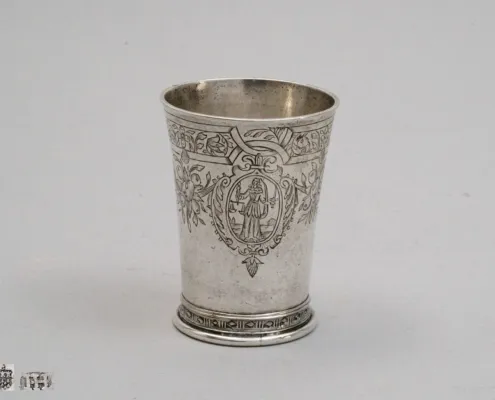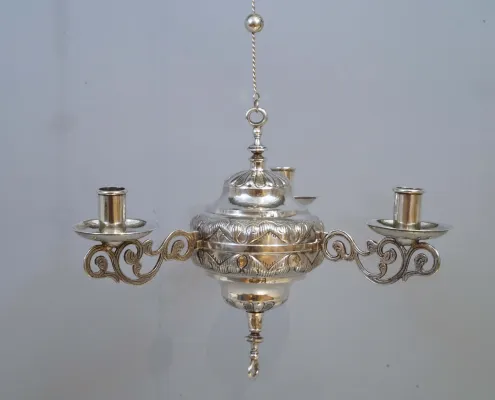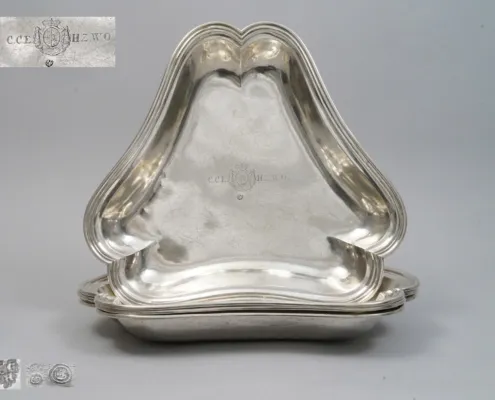Antique Silver and Hot Beverages: Coffee-, Tea- and Chocolatepots
INTERESTING NEW ACQUISITIONS
How about a warm cup of coffee poured from an original, historical, silver coffee pot? Or would you prefer a warm cup of tea or even better chocolate? Have you ever come up to the thought how close the history of hot beverages and silver in Europe and the world is? Let us follow a short historical path to it today. You will definitely not be able to resist the charm of historical silver and the strong aroma of a hot cup of your favorite hot drink after that.
The Origins of Coffee and Other Hot Beverages
People in the Ottoman Empire were introduced to coffee, originated from Ethiopia and Yemen, in the first quarter of the sixteenth century. By the middle of the century the beverage itself and the coffee houses began to play an important role in everyday life in the Empire.
European travellers knew coffee and tea since the sixteenth century. Tea came from Japan and China as a cultural influence resulted from the commercial connections of East Indian Companies (of the UK and the Netherlands) with the Far East.
Drinking chocolate was established in Europe also around the end of the seventeenth century. The hot beverage was prepared as a mixture of cacao, sugar and water. Chocolate was a quite expensive beverage, because the primary materials were also expensive.
All these hot beverages conquered the continent in the seventeenth century. They were at first sold in pharmacies and consumed as healing beverages. Since the end of the seventeenth century though, coffee was increasingly consumed for pleasure and for its effect on the alertness and attention of the body and the intellect. By the beginning of the eighteenth century and through the modish habits at the princely courts and of the bourgeoisie, coffee just like tea had already conquered the European Continent.
Hot Beverages in Fashion
A sense of consumption, delight, luxury and fashion seems to have surrounded coffee and tea by the eighteenth century. This is the case both for North-Western Europe as for other parts in the world. European goldsmiths were fast in reaction and had taken advantage of this coffee, tea and chocolate trend in order to produce new objects for these hot beverages. Coffee-, tea- and chocolate pots came since then in order to stay here!
Coffeehouses were the public places where the new luxurious objects for coffee could be seen. The intimate space of the luxurious household was the counterpart of these public life place. The man and woman of the eighteenth century indulged themselves in luxurious, simple or elaborate decorated coffee and teapots for their new drinking habit. As the coffee, tea and chocolate “folie” grew and became indeed a social habit, new silver objects were constantly added to the hot beverages apparatuses: milk jugs, sugar bowls/boxes or sugar casters, sugar nips, tablets … You can have a glance of almost all these types of objects at our webpage.
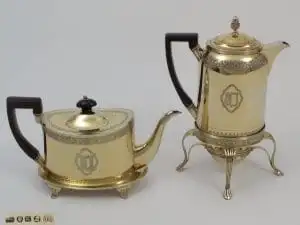
The Objects Around Hot Beverages
On the development of styles of the different coffee- and tea-pots one can say that the first coffeepots were strongly influenced by the Orient, origin of the coffee and tea. For instance, early English coffeepots had a conical lid with a pointed end. During the eighteenth century the lid had gained in curvature. The style developments of the period during 1710-20 gave the coffeepots an octagonal form, like this coffee-pot made in London shows.
The development of the form of the teapot has its own trajectory. England played however a defining role in it, due to the consumption of great quantities of tea there. The first silver teapots were fabricated in England since ca. 1670. By the beginning of the eighteenth century teapots are part of the household in England. The pear-shape and smooth, non-decorated teapots, like the one we show, applies to the stylistic developments of the early Georgian era.
The type of round teapot in English silver appears after the pear-shaped teapots and is influenced by the so-called “boccaro” or “buccaro” earthenware from China. The name “boccaro” comes from Spanish and Portuguese and was used for the imported earthenware from Mexico, Chile and Peru. Boccaro applied also to the Chinese, red and brown Yixing earthenware (later Ming-period) imported from China. The boccaro teapot of Helga Matzke features a fine, discretely decorated example of this style.
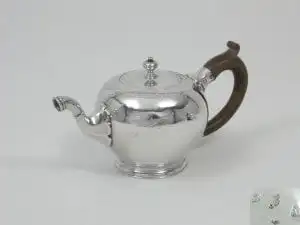
The new decorative style of the eighteenth century, the Neoclassicism, became gradually a popular vogue. During the last quarter of the eighteenth century – the George III period in British Silver – many teapots have been made of a sheet silver, in oval, octagonal or edged plan.
Teapots with a burner were invented in order to boil the tea water above a spirit lamp and then use it to prepare the tea using tealeaves. To this kettle with heater belonged often a silver table with similar decoration.
There are not always many preserved examples of teapots made in famous goldsmith’s European cities, like for instance Nuremberg. Particularly early examples of such objects as tea-pots are quite rare. Helga Matzke shows a wonderful teapot from Emmerich, the so-called Egoist. Practically every European city, where coffee and tea become a daily habit has its own styles of coffee- and tea-pots to show. Augsburg in Germany presents some very good and inspired objects, like this neoclassical set shows.
Chocolate-pots are basically quite similar to coffee-pots. During the eighteenth century, cacao was to be drunk only when foaming stirred. This influenced also the form of the silver pots. The chocolate pot has usually a screw-knob, so as to use the opening for a whorl.
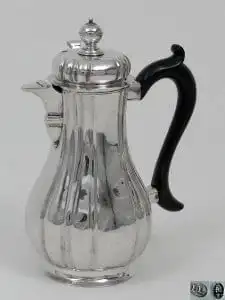
The Timelessness of Silver Services for Coffee and Tea
Ever since these hot beverages established themselves in Europe and the world, there have been many wonderful pieces of coffee-, chocolate- and tea-pots as well as services that made the drinking of them a daily ceremony and pleasure.
No wonder that the imaginative maker Johann Melchior Dinglinger made for the Royal court of Dresden an absolutely splendid coffee service – most probably however never used. Designers, makers and creators of the nineteenth and twentieth century have continued and continue to fashion wonderful coffee and tea services.
As we slowly approach to the festive period of the end of the year, why not offer yourself and family or friends a very artistic, historical and timeless gift for the small joys of the every-day life?
Selected Bibliography
Hernmarck, Carl, Die Kunst der europäischen Gold- und Silberschmiede von 1450 bis 1830, C.H. Beck Verlag: München, 1978.
Kafadar, Cemal, ‘How Dark is the History of the Night, How Black the Story of Coffee, How Bitter the Tale of Love: The Changing Measure of Leisure and Pleasure in Early Modern Istanbul’ in: Öztürkmen, Arzu & Birge Vitz, Evelyn (eds.), Medieval and Early Modern Performance in the Eastern Mediterranean, Turnhout: Brepols/Late Medieval and Early Modern Studies, vol. 20, 2014, pp. 243-69.
Remky, K. & Schäffer, G., Die Ernüchterung des Abendlandes: Kaffee und Tee erobern Europa, Kat. Ausst. 04.12.2010-20.03.2011, Aachen: Couven-Museum, 2010



